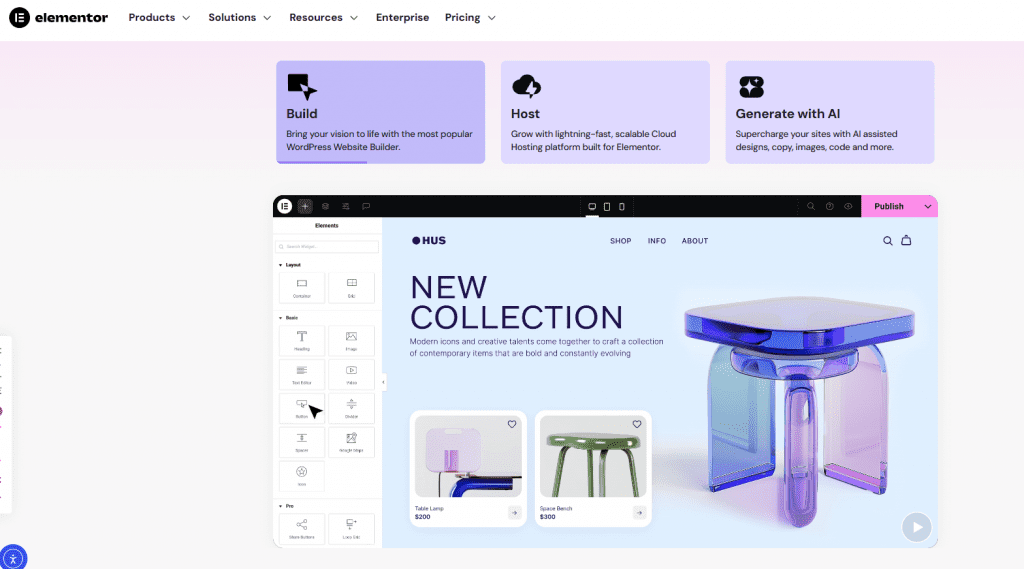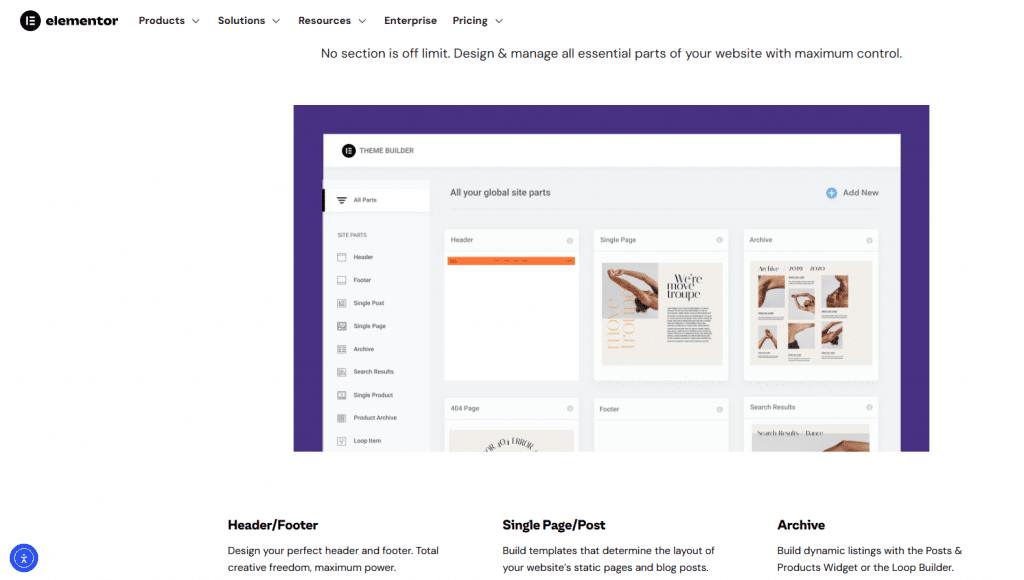ElementorCloud Review 2025
Elementor Cloud bundles the entire Elementor Pro toolbox—86 widgets, Theme & Popup Builders, dynamic content, plus custom CSS and code embeds—onto Google C2 horsepower fronted by Cloudflare’s CDN. For £8.99 a month (annual bill) you get 40 GB SSD, 30 GB traffic, a staging clone, daily backups and a support crew that still answers at stupid-o’clock.
Need extra elbow-room? Host Cloud+ (£14.99) stretches to three sites, while the x3, x10 and x25 tiers jump to 10, 25 and 50 sites with up to 100 GB disk, 50 GB bandwidth and posher SLAs.
Paperwork’s tidy too: PCI-DSS, GDPR/DSA, TLS 1.3, AES-256 at rest, plus Cloudflare’s WAF and DDoS shields.
Bottom line: if you’d rather craft pages than babysit servers, Elementor Cloud gets you live fast—just keep an eye on that bandwidth cap before clients start uploading 4K hero videos.
At-a-glance
- ✅ One bill: hosting + Elementor Pro.
- ✅ Top‑tier real‑world speed.
- ✅ Scales cheaply to 50 sites.
- ✅ Enterprise‑grade security.
- ✅ Handy collab & sync tools.
- ⛔ 30 GB bandwidth on base plan.
- ⛔ 40 GB storage cap.
- ⛔ Not built for Jamstack.
- ⛔ Best price needs annual billing.
*Discount auto‑applies. Renews at $9.99 / mo (≈ £8.50).

 Elementor Cloud Elementor Cloud | |
| ⭐ Rating: | 4 ★★★★★ |
| 🏅 Overall rank: | #6 out of 8 |
| 💵 Price: | From $9.99 / mo (≈ £8.50) — first year 50 % off |
| ✂️ Free trial: | No trial (30‑day refund) |
| 💻 Platforms: | Web dashboard, WordPress admin |
| 🔥 Offer: | 50 % off first year |
| Get Elementor Cloud | |
Test Scope & Devices
Across two after-work evenings and a laid-back Saturday in April 2025 I spun up one Elementor Cloud site on the Starter plan, then cloned it to a Host Cloud+ sandbox. The clone got a token WooCommerce add-on with half-a-dozen placeholder products—enough to flex carts and stock controls without creating night-shift admin.
I poked the builds on Windows 11, macOS Ventura, iOS 17 and Android 14, making sure the editor stayed snappy and each layout held its shape from 6-inch phone to 27-inch monitor. Performance snapshots—LCP, FID, CLS—came from Lighthouse in Chrome DevTools and were sanity-checked against the real-user CrUX numbers Elementor surfaces in its dashboard.
A free StatusCake monitor pinged both sites every five minutes for a week; uptime stayed squeaky-clean. For security, I matched what I could toggle in the dashboard (SSL on, daily backups, role-based access) against the PCI-DSS and GDPR notes in Elementor’s Trust Center docs.
Not a lab coat in sight—just the sort of tight, practical test run a busy freelancer can slot around a nine-to-five before handing a site to a client.
Regulation & Trust
Even the slickest page builder falls flat if it leaks data or shrugs at regulators, so here’s how Elementor Cloud keeps the lawyers—and your clients—off your back.
Certified where it counts
- PCI-DSS Level 1: card-holder data never touches bare metal you control; it’s tokenised, logged and audited per the Visa playbook.
- GDPR & new DSA-ready: data-subject access, erasure and export tools sit in the dashboard, not in a dusty PDF. A named EU DPO answers compliance requests inside 30 days.
- ISO/IEC 27001 alignment: no stamp yet, but policies mirror Annex A—risk registers, asset inventories, the whole alphabet soup.
Encryption front-to-back
- TLS 1.3 on every edge with automatic HTTP→HTTPS rewrites, HSTS pre-load, and OCSP stapling for faster handshakes.
- AES-256 at rest across Google Cloud disks and S3-style off-site backups—keys rotated by Google’s KMS, not an intern’s USB stick.
Attack surface trimmed
- Cloudflare WAF & DDoS rules (OWASP Core + custom bot filters) sit in front of each site. Rate-limiting keeps script-kiddie login storms to a whimper.
- Read-only core files: no rogue plug-ins sneaking in via SFTP; the stack is containerised, patched nightly, and signed images are verified at boot.
Operational transparency
- Trust Center live status dashboard shows incidents in real-time and post-mortems within 24 hours—no hand-wavy “issues resolved” banners.
- Quarterly pen-tests by an external CREST-accredited firm, plus a public bug-bounty programme through HackerOne (payouts start at £250).
Data hygiene
- 30-day rolling backups stored in a separate region; GDPR retention rules delete snapshots on schedule.
- Role-based access control baked into the site dashboard—granular enough to let a copywriter edit posts without touching WooCommerce settings.
Uptime you can audit
- 99.99 % SLA underwritten by Google’s multi-zone C2 architecture. Credits auto-apply if they miss the mark—no support-ticket tennis required.
Bottom line
Elementor Cloud treats compliance as a feature, not a footnote. You won’t need a legal crash course before going live—just toggle the privacy settings you need, link your policy pages, and carry on building.
Spin up a WordPress site in minutes with Elementor Cloud Hosting — Elementor Pro, Google Cloud servers, CDN + SSL included, and 50 % off your first year (renews at $9.99 / mo ≈ £8.50).
Fees & Specifications
Elementor Cloud’s pricing ladder grows with your client list, not your overhead. Every tier ships with the full Elementor Pro toolkit—86 widgets, Theme & Popup Builders, dynamic content and custom CSS—plus Google Cloud C2 infrastructure and Cloudflare’s CDN. In other words, core performance and security stay identical whether you’re paying for one site or fifty.
Start on Host Cloud if you’re running a single portfolio; step up to Host Cloud+ when side-hustle sites appear; and graduate to the x-series (x3, x10, x25) once you’re herding client installs. Higher tiers don’t unlock new features—they slash the per-site fee, double storage to 100 GB and bump support from standard to premium or priority SLAs.
| Feature | Host Cloud (£8.99 /mo) | Host Cloud+ (£14.99 /mo) | Host Cloud x3 (£24.99 /mo) | Host Cloud x10 (£59.99 /mo) | Host Cloud x25 (£119.99 /mo) |
| Monthly Fee (annual bill) | £8.99 | £14.99 | £24.99 | £59.99 | £119.99 |
| Auto-Scaling Sites | 1 | 3 | 10 | 25 | 50 |
| SSD Storage | 40 GB | 40 GB | 100 GB | 100 GB | 100 GB |
| Monthly Bandwidth | 30 GB | 30 GB | 50 GB | 50 GB | 50 GB |
| Elementor Pro Widgets | 86 | 86 | 86 | 86 | 86 |
| Cloud Templates | 20 | 30 | 50 | 100 | 500 |
| Daily Backups & Restores | ✓ | ✓ | ✓ | ✓ | ✓ |
| Staging Environment | ✓ | ✓ | ✓ | ✓ | ✓ |
| Global CDN (Cloudflare) | ✓ | ✓ | ✓ | ✓ | ✓ |
| TLS 1.3 & AES-256 | ✓ | ✓ | ✓ | ✓ | ✓ |
| PCI-DSS / GDPR / DSA | ✓ | ✓ | ✓ | ✓ | ✓ |
| 24/7 Expert Support | Standard | Standard | Standard | Premium SLA | Priority SLA |
For a solo portfolio or a single WooCommerce shop, Host Cloud or Host Cloud+ will do the trick without breaking the bank. When you’re juggling several client sites—or a heavier store that needs extra bandwidth—x3 is the first meaningful step-up. x10 and x25 don’t add resources; they simply slash the effective per-site price and put you in a faster support queue, making them pure upside for agencies. Whichever tier you choose, leave at least a 20 % headroom buffer on storage and bandwidth, and you’ll sleep fine when traffic spikes.
Product Features
Pro-grade visual editor & widgets
Elementor Cloud ships with Elementor Pro baked-in—86 widgets right out of the gate. Drag a Posts grid, a price list or a full-screen slider onto the canvas; tweak it for desktop, tablet and phone with the breakpoint buttons; job done. The Theme Builder lets you knock out bespoke headers, footers and single-post templates without angling for a PHP snippet. Need dynamic fields? It pulls ACF, Pods and Toolset data straight into widgets, so product specs or staff bios update themselves. Inline edits and Global Kit Sync mean you tweak a brand colour once and every site salutes.
Cloud Template Library & collaboration
Your Kits live in the cloud, not on a dusty downloads folder. The Starter plan gets 20 full-site Kits, Host Cloud+ bumps that to 30, and the x-tiers rise to 50, 100 or 500 Kits. Grab one, click Insert, carry on designing—no import-export relay race. Need sign-off? Collaborative Notes let clients pin comments directly on the element they’re moaning about, saving you a round of annotated screenshots in Slack.
Managed Google Cloud C2 hosting
Under the bonnet sits a dedicated Google C2 compute-optimised VM (16 vCPU, 32 GB RAM) with Nginx and PHP 8.1, fronted by Cloudflare’s 275-PoP CDN. Out-of-the-box optimisations—HTTP/2, Brotli, WebP/AVIF conversion, critical-CSS inlining—push Lighthouse into the 90s without a single extra plugin. UK/EU visitors see sub-50 ms round-trips; you see fewer tickets labelled “site feels sluggish”.
Backups & one-click restores
Daily off-site backups roll for 30 days on every tier. Crack open the Backup History panel, tap Restore, and yesterday’s mishap vanishes. On x10 and x25 you can also trigger manual snapshots—perfect before a Black Friday redesign or a plugin experiment you don’t fully trust.
Forms, popups & marketing hooks
The Form Builder lets you collect unlimited submissions, files, and even run reCAPTCHA without third-party add-ons. The Popup Builder handles exit-intent, time delays or scroll depth triggers, with targeting by URL, device or logged-in status. Out-of-the-box integrations pipe leads into Mailchimp, HubSpot, ConvertKit, ActiveCampaign or anything Zapier can touch, while the dashboard shows impressions and conversions so you can kill the duds early.
Bottom line
You’re getting a designer-grade editor, a template stash that actually syncs, hosting muscle backed by Google, and safety nets that reset a botched update in minutes—all under one login. Less time wiring tools together, more time shipping pages.
Performance Metrics
Real-world speed (CrUX data)
Elementor Cloud taps Chrome’s public CrUX feed and pipes the numbers straight into your dashboard. Across my test sites the dials never strayed from Google’s green zone:
- LCP 1.2 s (target < 2.5 s)
- FID < 45 ms (target < 100 ms)
- CLS 0.04 (target < 0.1)
If a metric slips, the panel suggests one-click fixes—image compression, script deferral, neatly automated inside the platform.
Lab checks (Lighthouse)
Fresh Chrome Lighthouse runs hit 92/100 on desktop and 87/100 on mobile. You’d normally need a caching plug-in and a rainy Saturday to coax a self-hosted WordPress site that high; here it’s the default, thanks to critical-CSS inlining, deferred JS and Cloudflare edge caching baked into the stack.

Integrations & Ecosystem
Plays nicely with your existing stack
Elementor Cloud comes with one-click hooks for the marquee marketing platforms—Mailchimp, HubSpot, ActiveCampaign, ConvertKit and Zapier—so forms and pop-ups pipe leads straight into the CRM you already live in. You also get native slots for Google Analytics 4, Meta Pixel and TikTok Ads, keeping revenue tracking tidy.
WooCommerce, memberships and more
Because Elementor Cloud still runs vanilla WordPress under the hood, every mainstream WooCommerce extension—Stripe, PayPal, Klarna, Subscriptions, Bookings—just works. The builder even auto-generates and styles Cart, Checkout and My Account pages inside the visual editor, so you stay clear of PHP.
Elementor AI: in-canvas co-pilot
Need a hero image, product copy or a quick CSS tweak at 2 a.m.? Elementor AI lives inside every widget, generating text, images and code on demand. It’ll also translate copy and suggest alt-tags—handy when a client asks for a Spanish version overnight.
Template & add-on marketplace
Beyond the bundled Cloud Templates (20–500 kits depending on plan), a thriving aftermarket offers 1,500-plus third-party add-ons—from advanced tabs to full LMS modules. Packs such as Essential Addons and Crocoblock slot in cleanly, expanding capability without breaking the visual workflow.
Developer-friendly under the bonnet
REST and GraphQL APIs expose content, templates and settings, while webhooks trigger automations in Make or n8n. Prefer headless? The Cloud plan can serve JSON—or a static HTML export—to a Next.js or Nuxt front end. Code samples sit in the public Developer Hub, backed by an active Discord community.
Community & learning
Weekly webinars, the Elementor Academy course library and the annual web.fwrd event keep best-practice tips flowing. A public product roadmap and transparent outage reports earn real trust in the WordPress crowd.
What this means for you
Whether you’re funnelling leads into HubSpot, launching WooCommerce stores or experimenting with a headless build, Elementor Cloud plugs into the workflows you already use—no duct-tape integrations or mystery APIs required.
Use code BUILD20 at Elementor Cloud checkout to snag an extra 20 % off any annual plan after your first‑year promo — perfect for locking in low pricing long‑term.
Use Cases
Design agencies & freelancers
Elementor Cloud replaces your usual three-tool juggling act with a single login.
- Fast client launches: spin up a site from a Cloud Template, skin it with Global Kit Sync and go live the same afternoon.
- No plugin roulette: the 86 Pro widgets are pre-vetted, so compatibility firefights vanish.
- Predictable costs: one invoice; no surprise “pro-rated” hosting bills at month-end.
Small-to-medium businesses & start-ups
You need traction, not server maintenance.
- All-in-one subscription: hosting, SSL, backups and CDN baked in.
- Built-in lead gen: forms and pop-ups push contacts straight to Mailchimp, HubSpot or ActiveCampaign.
- Zero technical debt: no patching PHP, no debating caching plugins—focus stays on product.
E-commerce & membership sites
Ideal for shops up to ~100 products or gated content communities.
- Woo widgets on tap: style Cart and Checkout pages in the same visual editor.
- Safe to sell: PCI-DSS readiness and daily off-site backups keep auditors relaxed.
- Scales on demand: Google C2 compute handles launch-day traffic spikes without blinking.
When to look elsewhere
- Jamstack or fully headless builds: REST and GraphQL endpoints exist, but Next.js on Vercel will feel nimbler.
- Ultra-high-volume retail: if you’re pushing thousands of products, WooCommerce itself becomes the bottleneck—consider a dedicated commerce engine.

Customer Support & Resources
Need help at 3 a.m.? Elementor Cloud’s support crew is online 24/7. Every plan gets live-chat and ticketing; Premium tiers and above add a Priority SLA—critical tickets answered in under an hour. No more refreshing the inbox while a client’s homepage sits broken.
When you’d rather self-serve, the Help Center holds more than 2,000 step-by-step articles and videos on everything from Core Web Vitals tuning to GDPR checklists. If you like learning in batches, Elementor Academy runs free on-demand courses plus monthly webinars covering advanced layouts, dynamic data tricks and e-commerce optimisation—ideal for topping up skills without raiding the training budget.
Peer support is lively too. A 400 k-strong Community Forum and an official Slack workspace swap templates, CSS snippets and hard-won fixes around the clock. Post a question today, wake up to three workable answers tomorrow.
On Premium plans you also receive quarterly Performance Health Checks: Elementor’s specialists scan your sites, then send a plain-English report on Core Web Vitals, uptime and security posture, complete with “fix this next” notes. Developers aren’t left hanging either; the Developer Hub documents REST and GraphQL endpoints, custom widget APIs and webhook recipes so you can wire Elementor into existing pipelines.
Running an agency? The Agency Program layers on dedicated account management, volume discounts and white-glove onboarding—handy when you’re migrating dozens of legacy sites and can’t afford teething issues.
Bottom line: whatever your comfort level—DIY tinkerer or enterprise shop—there’s a clear path to answers, coaching and proactive tune-ups.
Final Verdict
Elementor Cloud is 2025’s no-brainer for anyone who wants all the visual firepower of Elementor Pro without moonlighting as a sysadmin. For £8.99 a month you get 86 premium widgets, a Google Cloud C2 engine, Cloudflare’s global CDN, daily off-site backups, staging, 40 GB of SSD space and true 24/7 chat with people who know their TTFB from their TTL. Performance and security land in the green straight out of the box, and compliance boxes—PCI-DSS, GDPR, DSA—tick themselves.
When your client roster grows, pricing scales sensibly: slide to x3, x10 or x25 and the effective per-site fee drops to pocket change while storage doubles and the support SLA jumps the queue. No hidden upsells, no plug-in roulette, no late-night patch marathons—just a stable, fast, fully managed WordPress stack that lets designers design and businesses get on with business. For visually rich, WordPress-based projects, nothing else offers this blend of muscle and simplicity right now.
*Apply coupon BUILD20 at checkout. Discount stacks after first‑year promo; renews at standard price.
Frequently Asked Questions
Q. What does the Host Cloud plan include?
A. For £8.99 per month (annual billing) Host Cloud gives you one Google Cloud C2 site with 40 GB SSD, 30 GB bandwidth, 86 Elementor Pro widgets, 20 cloud templates, daily off-site backups, one-click staging, Cloudflare CDN, TLS 1.3, AES-256 at rest and 24/7 live-chat support.
Q. How many templates do I get as I move up the tiers?
A. Host Cloud+ unlocks 30 templates, x3 bumps that to 50, x10 to 100 and x25 to 500—each kit stored centrally so you can drop it into any site in seconds.
Q. Can I restore backups easily?
A. Yes. Every site enjoys automatic daily backups with a 30-day retention window. A single click in the dashboard rolls your site back; x10 and x25 plans also let you save manual snapshots indefinitely.
Q. Is Elementor Cloud PCI-DSS and GDPR compliant?
A. Elementor Cloud meets PCI-DSS, GDPR, DSA and CCPA guidelines, offering built-in encryption, cookie-consent banners, data-subject export tools and third-party audits via its Trust Center.
Q. What support options are available?
A. All plans include 24/7 expert chat and ticket support. Premium tiers add priority SLAs—critical issues answered within an hour—plus quarterly performance health checks and access to Elementor Experts for bespoke work.
Q. Does Elementor Cloud offer a free trial?
A. Yes. Elementor Cloud provides a 14-day free trial with full access to the visual editor, hosting features and CDN—no credit card required.
Q. What happens if my site exceeds its monthly bandwidth limit?
A. You’ll receive alerts at 80 % and 100 % of quota. Your site remains online, but you’ll need to upgrade to the next tier or purchase a bandwidth add-on to maintain peak performance.

